Enterprises in the US and the UK lose a combined $37 billion each year due to something as avoidable as employee misunderstandings.
Poor communication is one of the biggest causes of such costly misunderstandings. This is why recruiters worldwide consider communication assessments essential during the hiring process. Besides hiring good communicators, companies also try to upgrade the communication skills of their existing workforce with communication training programs.
But assessing communication skills quickly and efficiently isn’t easy, is it? If you’re also struggling with setting up an effective communication testing system, you’ve landed at the right place.
In this guide, you’ll learn all you need to know to conduct communication assessments that enhance employee productivity, sales, and customer satisfaction.
What Is a Communication Assessment?
A communication assessment tests a candidate’s or employee’s skills and knowledge of oral, written, or nonverbal communication. You can conduct communication tests as a part of your hiring, training, or succession planning programs to ensure every employee is fully equipped with the communication skills required for their role.
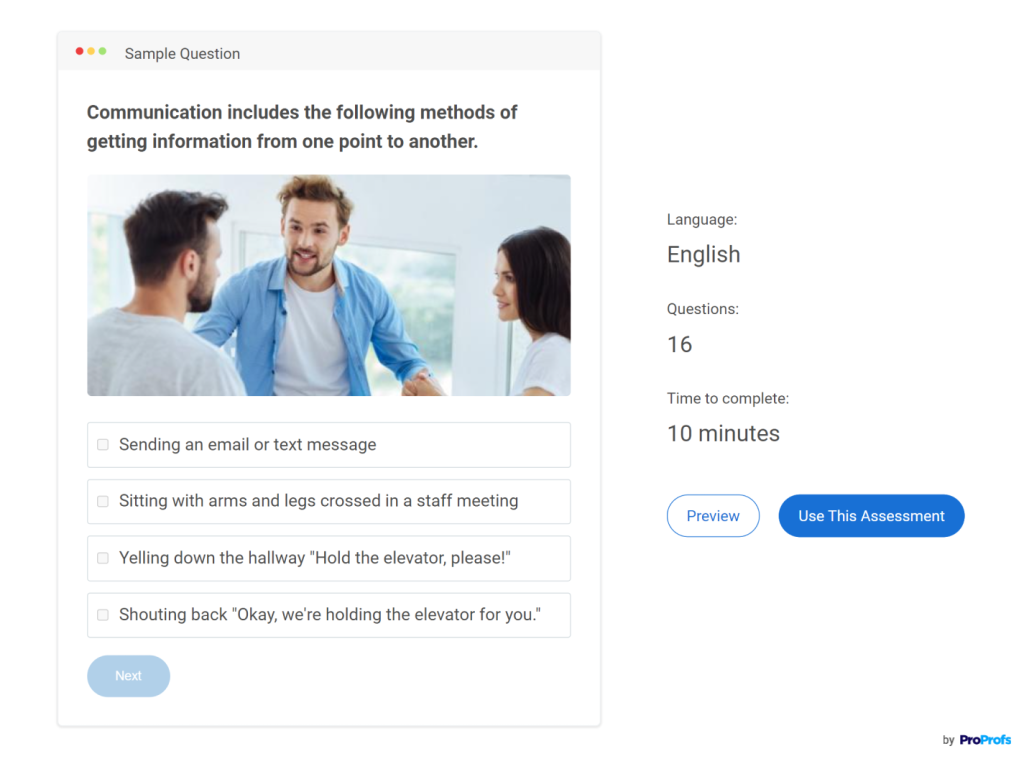
Strong communication plays a key role in several crucial business requirements, such as:
- streamlining collaboration and workflows to boost productivity
- establishing and maintaining customer, client & partner relationships
- Setting up effective leadership and management structures
- hazard prevention and management
- compliance management
…and much more.
Communication assessment tests help you meet these requirements by letting you easily evaluate skills, such as:
- Communicating face-to-face and over email, phone, and other such mediums
- Reading and comprehending technical or non-technical information and messages
- Communicating through non-verbal mediums, such as facial expressions, gestures, etc.
Watch: How to Create an Online Assessment
Types of Communication Assessments
Now that you know the meaning of communication assessment, let’s explore the diverse range of assessments you can use to evaluate communication skills, from verbal and written proficiency to nonverbal cues and interpersonal dynamics.
1. Verbal Communication Assessments
These assessments focus on an individual’s ability to articulate thoughts and ideas clearly using spoken formats.
- Presentations: This assessment method evaluates oral communication skills, particularly the ability to present ideas and engage with an audience effectively.
- Interviews (Simulated or Recorded): Used to evaluate communication skills in a conversational setting, these communication assessments reveal how candidates express themselves and respond in professional dialogues.
- Role-Playing Exercises: These scenarios test the ability to communicate and adapt in various interpersonal situations, which is crucial for effective team collaboration and client interactions.
2. Written Communication Assessments
These assessments measure the ability to effectively communicate through writing.
- Writing Samples (Emails, Reports): Analysis of writing samples, such as emails or reports, provides insights into an individual’s capacity to express information clearly and professionally in writing.
- Grammar & Punctuation Tests: Essential for roles requiring precision in written communication, these tests assess an individual’s understanding and application of basic writing rules.
- Editing Exercises: These exercises target the skills required to refine and clarify written content, evaluating an individual’s attention to detail and ability to improve written communication.
- Essay Writing Prompts: Used to assess the ability to organize and express thoughts coherently in writing, this assessment type is important for roles involving the creation of comprehensive reports or proposals.
- Business Writing Scenarios: These specialized exercises evaluate proficiency in crafting business-specific documents, which is crucial for roles involving corporate communication.
3. Listening Skills Assessment
While often overlooked, listening skills are just as important as speaking or writing skills for meaningful, trust-building communication. You can conduct a listening skills assessment to test the assessment taker’s listening comprehension and knowledge of active listening best practices.
- Comprehension Exercises: These exercises test the ability to understand and retain information from spoken communication.
- Active Listening Tests: These involve scenarios where individuals must demonstrate their ability to actively engage with what is being said, showing understanding through appropriate responses or questions.
- Feedback and Paraphrasing Exercises: Assessing the ability to provide feedback or paraphrase what was heard to confirm understanding.
4. Nonverbal Communication Assessments
Nonverbal cues significantly impact interpersonal interactions, making it crucial to gauge an individual’s proficiency in this subtle yet vital aspect of communication.
- Video-Based Analysis: This involves the study of recorded interactions to understand an individual’s nonverbal cues, such as body language and facial expressions.
- Behavioral Exercises Focusing on Active Listening and Empathy: These activities assess nonverbal aspects that are crucial for roles requiring high levels of interpersonal engagement and client-facing interactions.
5. Personality and Social Skills Assessments
These communication assessments delve into the personality traits and social skills that underpin effective communication, particularly important in team and client dynamics.
- Tests Measuring Communication Traits: These evaluate traits like confidence, assertiveness, and teamwork ability, offering insights into an individual’s natural communication style and their potential fit within a team.
For example, a communication style assessment might reveal if someone tends towards a more passive or aggressive style, which can be valuable information for team building and conflict resolution.
- Situational Judgment Tests: Focused on assessing how individuals handle specific communication scenarios, these tests provide valuable insights into how potential hires might react in real-world professional situations.
By utilizing these diverse communication assessments, organizations can gain a comprehensive understanding of a candidate’s or employee’s communication strengths and areas for development.
This holistic approach is instrumental in making informed hiring decisions, tailoring training programs, and providing targeted coaching to enhance team effectiveness and individual career growth.
Common Communication Styles
In the workplace, communication is more than just exchanging information; it’s about understanding individual styles and preferences. Recognizing these varying approaches is crucial for fostering teamwork, reducing conflict, and enhancing communication overall.
- Assertive
Assertive communicators express themselves clearly and confidently while respecting others. They are direct but not aggressive, and they actively listen to others’ perspectives.
Example: In a team meeting, an assertive communicator might say, “I understand your point, but I think we should consider this alternative approach. Here’s why…” They would present their ideas clearly and respectfully while also acknowledging the other person’s perspective.
- Passive
Passive communicators tend to avoid conflict and may struggle to express their needs or opinions. They may come across as hesitant or agreeable, even when they disagree.
Example: If a colleague takes credit for their work, a passive communicator might say nothing, even though they feel upset. They may avoid confrontation and hope the situation resolves itself, even if it means not getting the recognition they deserve.
- Aggressive
Aggressive communicators can be forceful, demanding, and even disrespectful. They may prioritize their own needs over others and may not listen effectively.
Example: An aggressive communicator might interrupt others frequently during a meeting, dismiss their ideas, and insist on having their own way. They may raise their voice or use intimidating language to get their point across.
- Passive-aggressive
Passive-aggressive communicators express negative feelings indirectly, often through sarcasm, subtle behaviors, or backhanded compliments.
Example: A passive-aggressive communicator might say, “Oh, that’s a great idea… if we were living in the 1950s.” They may appear to agree on the surface but use sarcasm or subtle digs to express their disapproval.
Which Is the Best Communication Style?
While each style has its uses, assertive communication is generally most effective for these reasons:
- Respectful: Balances expressing needs with acknowledging others.
- Collaborative: Encourages open dialogue and idea sharing.
- Reduces conflict: Addresses issues directly and respectfully.
- Builds relationships: Fosters trust and rapport.
Adaptability is key. While assertiveness is often ideal, consider:
- Passive: May be suitable for de-escalating tense situations.
- Aggressive: May be necessary in emergencies requiring immediate action.
The best style is the one that’s most effective in the given situation.
FREE. All Features. FOREVER!
Try our Forever FREE account with all premium features!
How to Choose the Right Type of Communication Assessment
Choosing the appropriate communication assessment is crucial for accurately evaluating candidates or employees. Here are some key factors to consider when selecting the right assessment:
1. Job Requirements and Communication Needs: Take into account the job’s specific requirements. Roles emphasizing strong verbal skills, such as sales or customer service, may call for oral communication assessments like presentations or role-playing exercises.
Conversely, positions that involve extensive written communication, such as those requiring detailed documentation or report writing, may require rigorous written communication assessments.
2. Assessment Format and Cost: Consider the assessment format and its compatibility with your evaluation goals and logistical capabilities. Determine whether a written test, practical exercise, or interactive simulation aligns best with your needs.
Additionally, consider the cost associated with the assessment, including any materials, software, or personnel required for effective administration and evaluation.
3. Validity and Reliability of the Assessment: Ensure that the chosen assessment accurately measures the communication skills it claims to test (validity) and provides consistent results over time and across different groups (reliability). Using established assessments with a proven track record can enhance the credibility of your evaluation process.
4. Candidate Experience and Potential Bias: Consider the candidate’s experience during the assessment process and align it with your organization’s values and culture. Be mindful of potential biases that may exist in assessments.
Strive to create a fair and unbiased assessment that supports candidates from diverse backgrounds, fostering equal opportunities and promoting diversity in your workplace.
By carefully considering these factors, you can select a communication assessment that not only meets your specific needs but also contributes to a fair, effective, and inclusive evaluation process.
How to Use Communication Assessments Effectively
Communication assessments are valuable tools for evaluating and developing communication skills. To make the most of these assessments, follow these strategies:
1. Interpret Results and Identify Strengths and Weaknesses
- Comprehensive Analysis: Thoroughly analyze the assessment results, going beyond scores to understand the nuances of each individual’s communication style.
- Identifying Patterns: Look for recurring themes or patterns in the results to identify specific areas of strength or weakness, such as nonverbal communication or written expression.
- Contextual Evaluation: Consider the job role and career stage when evaluating results. A minor weakness in one role may be more significant in another.
2. Provide Feedback and Recommendations for Improvement
- Constructive Feedback: Give specific and actionable feedback based on the assessment results. Highlight both strengths and areas needing improvement.
- Personalized Improvement Plans: Develop tailored recommendations for improvement, such as training sessions or one-on-one coaching, based on individual needs.
- Encouraging Self-Reflection: Foster self-awareness by encouraging individuals to reflect on their communication skills and their impact on professional interactions.
3. Effectively Integrate Assessments into the Hiring and Training Process
- Aligning with Job Requirements: Choose assessments that align with the specific communication skills needed for the job. For example, prioritize assessments that evaluate public speaking skills for roles that require frequent presentations.
- Continuous Training: Incorporate communication skills evaluation tests into ongoing training and development programs to track progress and identify new areas for improvement.
- Balancing With Other Evaluations: Use communication assessments as part of a balanced evaluation strategy, complementing other assessment tools and considering multiple factors in hiring and training decisions.
- Promoting a Communication-Focused Culture: Use the insights from communication assessments to cultivate a workplace culture that values and prioritizes effective communication. This can lead to improved teamwork, productivity, and employee satisfaction.
Addressing Common Challenges & Concerns
-
Mitigating Bias:
To ensure fair and accurate communication assessments, it’s important to address potential biases proactively. Break down barriers by selecting assessments that have undergone rigorous validation for fairness.
Diversify your assessment methods and involve multiple evaluators to foster objectivity. By leveling the playing field, you create an inclusive environment that promotes equal opportunities for all candidates.
-
Creating a Positive Candidate Experience:
Put your candidates at ease by providing a seamless and engaging assessment experience. Clearly communicate the purpose and expectations of the assessment process, keeping them informed at every step.
Offer guidance and support, demonstrating your commitment to their success. By boosting candidate confidence, you not only encourage their true communication potential but also leave a lasting positive impression.
-
Aligning Assessments With Company Culture:
Your organization thrives on its unique culture and values. Ensure your communication assessments reflect these aspects by tailoring them accordingly.
Assess how candidates’ communication styles align with your company’s core beliefs. By focusing on culture fit, you build a strong foundation of effective communication that resonates with your organization’s identity.
What Are the Benefits of Communication Tests?
Communication tests provide an easy way to test communication skills, enabling you to hire good communicators and deliver effective training to improve the communication skills of your existing employees. This way, they help ensure that your business gets all the benefits of having a workforce with strong communication abilities.
Let’s have a look at these benefits in detail now:
- Teamwork and Collaboration
Good communication is essential for result-oriented collaboration. It enables team members to quickly exchange ideas, knowledge, and information and fosters team building and trust, which can have a huge, positive impact on your bottom line.
The good bonding between employees also improves employee satisfaction and engagement, reducing turnover.
An interpersonal communication skills test can reveal which candidates and employees have the communication abilities needed for successful teamwork.
- Conflict Resolution
Just as miscommunication can create issues, effective communication can help resolve, manage, or even avoid them. Discussions among co-workers that feature careful listening and professional, polite responses result in creative solutions to disagreements and speedy conflict resolutions.
Such discussions can even enable employees to brainstorm new, more effective ways of doing things.
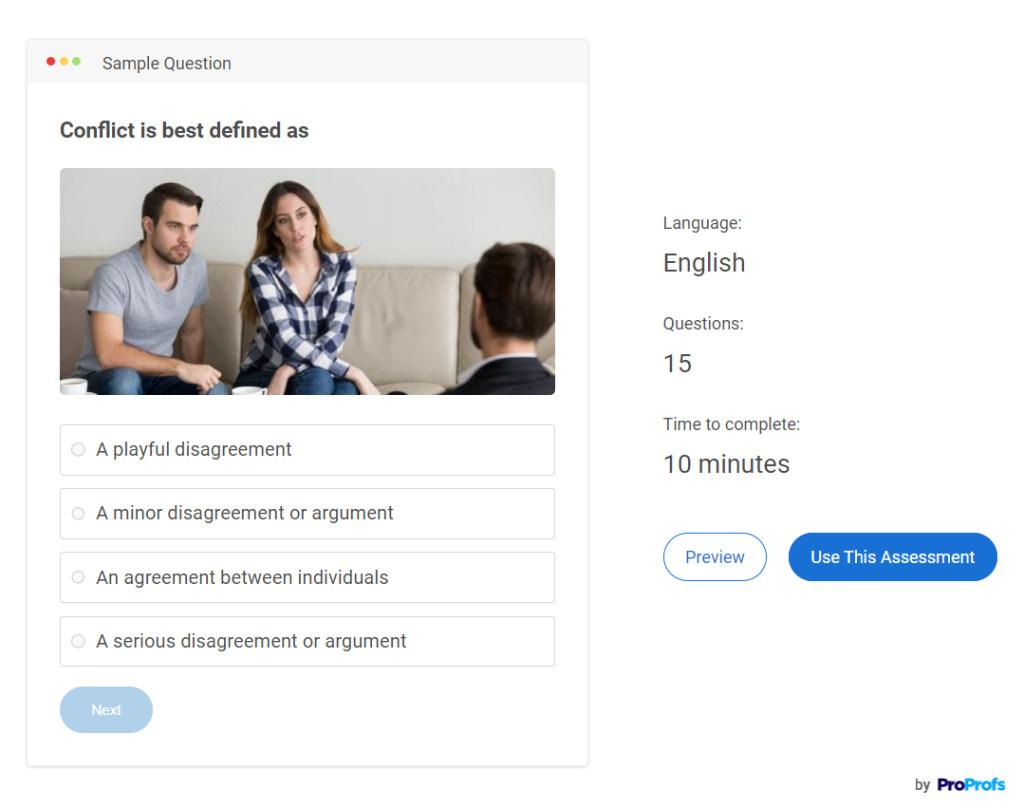
Pro Tip: If you’re assessing communication skills as part of a conflict resolution training program, conducting a conflict management style assessment would also be a good idea. This way, you can teach employees how to resolve conflicts using effective communication combined with the knowledge of their conflict style.
- Productivity
Employees can perform their jobs effectively only if they fully understand the information, guidelines, and suggestions they receive. Also, in case of misunderstandings, employees must be able to ask the right questions in the right way to clear them up quickly.
Besides minimizing misunderstandings and streamlining information flow, there are other ways workplace communication improves productivity, such as:
- It helps have more productive meetings.
- It improves employee engagement, which in turn reduces absenteeism and increases productivity.
- It enables employees to keep one another accountable.
- It builds a healthy work culture, improving employee motivation.
- Positive Work Environment
Good communication helps create a positive work culture and environment by minimizing misunderstandings, conflict, and animosity between employees.
This is especially true for diverse workplaces that face a greater potential for miscommunication and communication barriers stemming from cultural differences. Building a great communication culture with an adequate focus on cross-cultural communication is a highly effective way to promote diversity, equity, and inclusion.
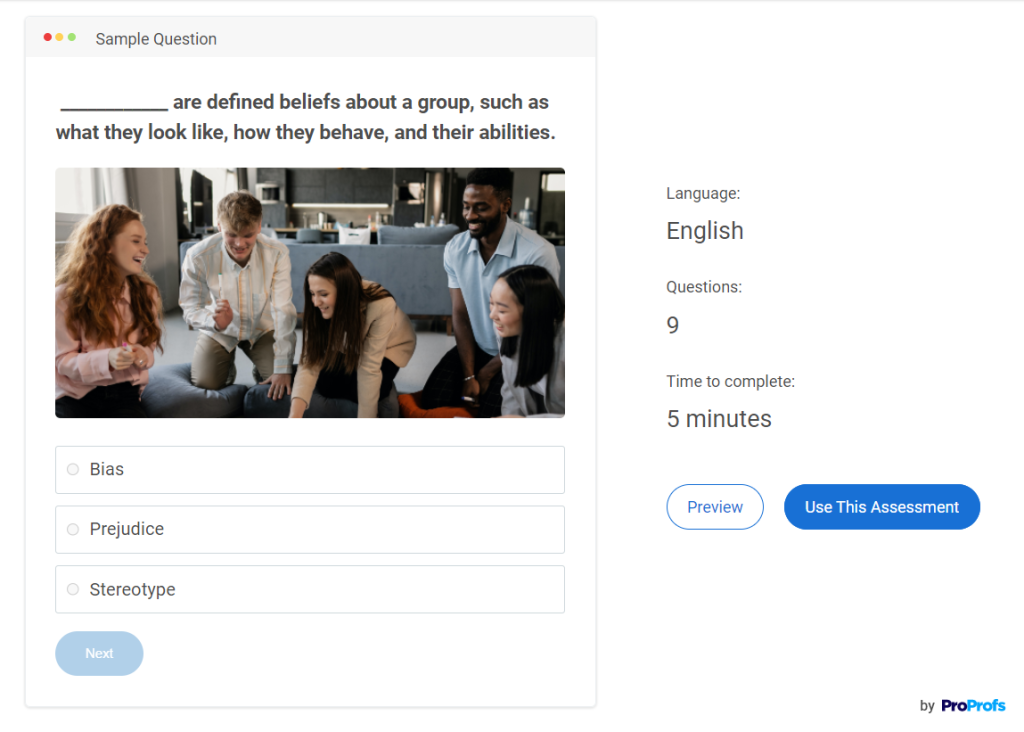
- Better Customer Relationships
According to a report by Salesforce, as many as 79% of business buyers and 69% of consumers admit to making purchase decisions based on customer service quality. This highlights just how important it is to maintain excellent customer relationships.
Communication is a foundational element in providing effective customer service and managing customer expectations. Communication skills, such as active listening, email etiquette, empathy, and confidence, contribute to creating positive, trust-building customer experiences and improving customer retention and brand loyalty.
- Better Leadership & Employee Feedback
Leaders must be effective at various things, such as:
- making strong connections with subordinates, peers, and seniors
- influencing, inspiring, and guiding people
- giving constructive employee feedback
All of this requires top-notch proficiency in verbal and nonverbal communication.
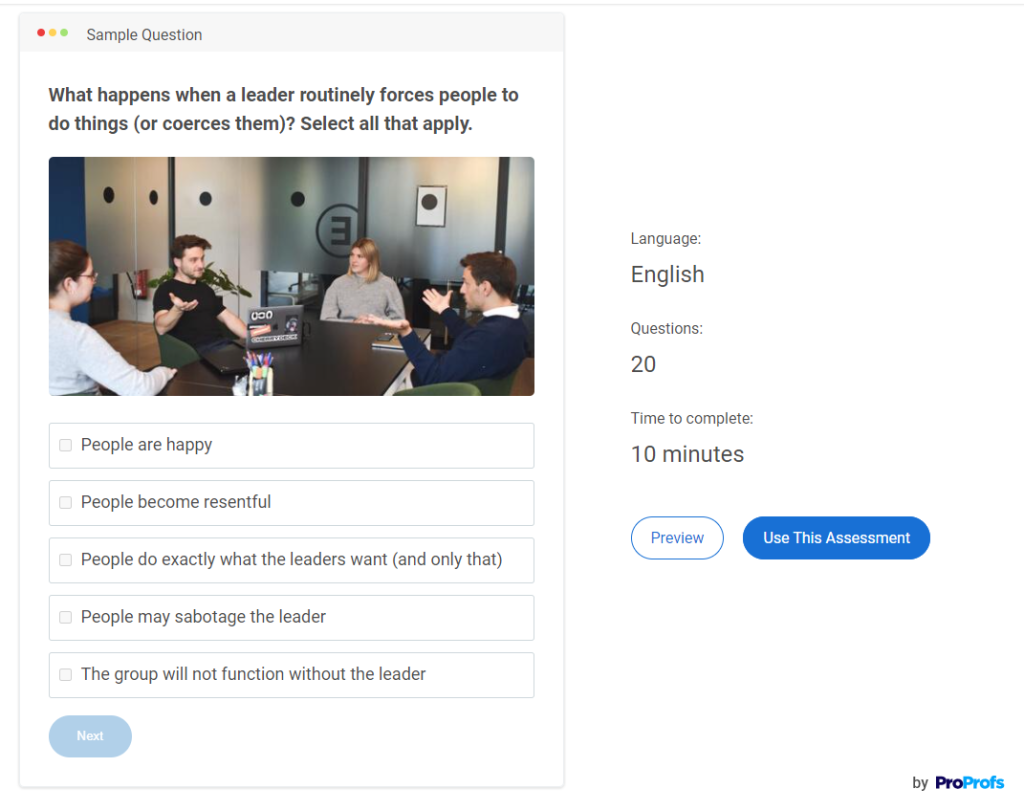
When it comes to feedback, leaders must also receive valuable feedback to help employees, meaning that effective leadership is only possible if there’s a culture of good communication in the workplace.
Pro Tip: To implement a streamlined 360-degree feedback system, you can use an online survey software, such as ProProfs Survey Maker, that lets you easily collect feedback anonymously using 20+ question types.
- Persuasion & Negotiation
Having employees with good persuasion and negotiation skills offers several advantages, such as:
- Faster group decision-making
- Improved productivity
- Efficient customer service
- More sales
- Better hiring
Good communication is essential for properly implementing persuasion and negotiation tactics to achieve the desired results. This is equally true whether you’re talking to employees, customers, or job candidates.
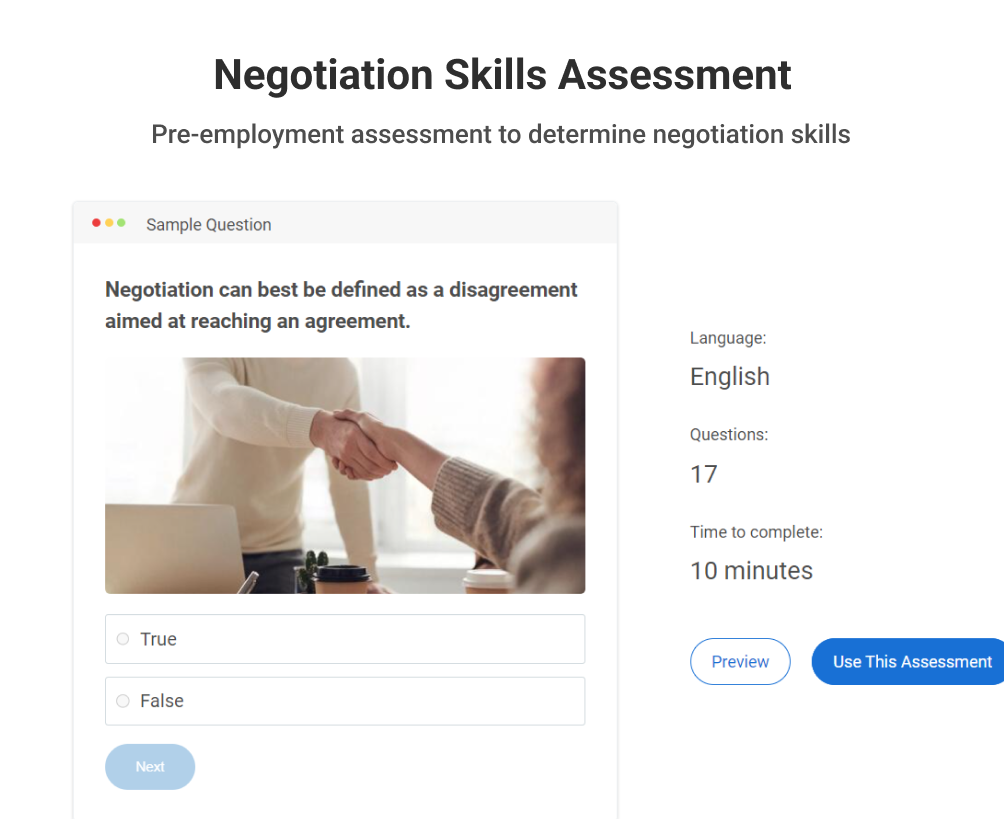
- Improved Safety
Creating a safe work culture involves a lot of efficient communication. Employers need to use clear and impactful messages to provide information about safety hazards and precautions and what to do in case of a hazard or emergency.
Similarly, creating a good communication culture also ensures that employees can easily ask for and provide help regarding safe operating procedures.
- More Innovation
Effective and open communication is a vital ingredient for innovation. Communication skills empower employees to freely share their ideas among themselves and with the leadership. This enables a group effort that can result in radically creative ideas and solutions to achieve specific goals.
Those were the various benefits you can get by using communication assessment tests to hire and train better and improve workplace and business communication.
A key thing to note here is that when it comes to communication training, communication skills assessment tests not only help enhance knowledge comprehension and retention but also help you deliver better training.
You can conduct communication assessments to find skill gaps and personalize your training. And, after the training is done, you can conduct assessments to check training effectiveness and modify your program accordingly.
Pro Tip: To make your communication training programs even more impactful, you can use an online learning management system, such as ProProfs Training Maker. This way, you can deliver communication training anytime, anywhere, using pre-built and customizable courses featuring videos, assessments, presentations, surveys, and more.
Now, let’s look at how you can create communication tests online and optimize them for success.
How to Create an Online Communication Assessment Quiz
Here’s the process for creating communication testing quizzes in a few simple steps.
Step 1: Pick a pre-made communication skills test, generate a quiz with AI, or start from scratch.
Step 2: Add questions using AI, by importing from a question bank, or by creating manually.
Step 3: Automate scoring by assigning points to questions.
Step 4: Configure settings for security, notifications, etc.
Step 5: Customize the look and feel.
FREE. All Features. FOREVER!
Try our Forever FREE account with all premium features!
Tips to Create an Effective Communication Assessment Quiz
While creating an online communication test is a straightforward process, there are some things you can do to make sure your tests get you the best results.
- Customize the Quiz for the Role
If you’re creating a communication assessment to hire for a particular role, you must have full clarity regarding the job requirements before drafting your questions. The more clarity you have on this, the more impactful the test will be.
For example, you’d want to ask somewhat different questions if you’re hiring for a leadership role compared to a junior or entry-level one.
Similarly, it would be best to create a separate test for hiring for a customer-facing role, such as customer service or sales, and a separate one for other roles. Check out the communication assessment example below to know what we mean.
- Include Both Open-Ended & Closed-Ended Questions
The best communication assessments contain a healthy mix of open-ended, essay-style questions and objective question types, such as multiple-choice, checkbox, fill-in-the-blanks, matching, etc.
Watch: Question Types for Online Assessment
Objective question types let you assess knowledge of communication best practices, such as using the right body language and facial cues or ensuring email etiquette. Meanwhile, open-ended questions let you check writing skills, thought clarity, empathy, and more.
- Include Audio/Video Response Questions
Video response questions are an amazing way to test someone’s speaking ability and use of facial expressions for communication. Audio/video response questions also let you ask open-ended questions more engagingly and conduct remote interviews.
When it comes to remote interviews, video questions offer unmatched flexibility by removing scheduling barriers. The interviewer can record their questions and share the quiz with the candidates, who can then record their responses at their convenience. Doing so lets you easily hire people from any time zone.
- Ask Situational Questions
Situational communication questions present the assessment taker with a hypothetical situation requiring deft communication and ask them how they would deal with it. While commonly used in pre-employment tests to check practical knowledge and judgment, such questions can also make training more engaging.
- Use Images and Videos in Questions
You can add images and videos to your communication assessment test in various ways to improve its effectiveness:
- Adding images to questions makes them more visual and engaging.
- You can add a video or image and ask questions based on it.
- You can create answer options featuring images or even image-only options.
Watch: How to Create a Video Quiz
- Provide Feedback
When conducting communication assessments for communication training, make sure you provide engaging feedback to your learners to help them in their self-learning. You can provide this feedback in two ways:
- Add feedback for each question that will be displayed either at the end of the quiz or instantly after each question is answered.
- Provide personalized feedback in text or video form once you receive a test taker’s report.
- Choose the Right Assessment Tool
Choosing the right communication skills assessment tool lets you create highly engaging and insightful communication tests and implement the best practices shared in this section. Some of the key benefits of using quality assessment software are:
Good communication testing tools are easy to use
- They let you create communication assessments quickly using ready-made resources.
- Let you accurately compare candidates and analyze learner performance using robust reporting and analytics.
- Provide several security features for test privacy and cheating prevention.
- Let you add a wide variety of multimedia to your quizzes and assessments.
- Let you customize your quizzes your way by providing all essential test settings and configurations.
- Integrate with HRIS systems to manage hiring and training data.
Watch: How to Choose the Best Assessment Software
Types of Questions in Online Communication Assessments
Communication assessments utilize a diverse range of question types to evaluate all aspects of communication skills. Here are some of the most effective formats:
- Multiple Choice
This format presents a question with several answer options, requiring the test-taker to select the correct one. It effectively assesses knowledge of communication principles, best practices, and etiquette. For example, a question might ask about the most appropriate way to address a customer complaint.
- True/False
This simple format presents a statement, and the test-taker must determine whether it’s accurate or not. This is useful for quickly assessing understanding of a wide range of communication concepts.
- Checkbox
Checkbox questions allow for multiple correct answers, enabling assessment of nuanced understanding and problem-solving skills. They are useful when evaluating situations where several solutions might be appropriate, such as identifying effective conflict resolution techniques.
- Fill-in-the-Blanks
This format requires test-takers to complete a sentence or paragraph with missing words, testing their recall and understanding of key terms and definitions. For example, a question might be,
“The three components of effective communication are _______, _______, and _______.”
- Essay
Essay questions require written responses, allowing for an evaluation of critical thinking, persuasive writing, and the ability to construct well-reasoned arguments. This format is ideal for assessing a test-taker’s ability to express themselves clearly and persuasively in writing.
- Matching
This format requires test-takers to connect corresponding elements, such as matching communication styles to their descriptions. It assesses knowledge of communication models and the ability to recognize relationships between concepts.
- Comprehension
Comprehension questions involve reading a passage and answering questions related to it. They test reading and analysis skills that are crucial for understanding workplace documents such as instructions, reports, and emails.
- Video/Audio Response
This format allows for the assessment of presentation skills, nonverbal communication, and clarity of expression through recorded or uploaded video/audio responses. It is useful for evaluating communication skills in dynamic settings, allowing observation of delivery, tone, and nonverbal cues.
Examples of Communication Assessment Tests
Here are some examples of communication assessment quizzes from ProProfs’ assessment library:
- Workplace Communication Assessment
Employees must communicate with each other in various ways daily to get the job done. This includes face-to-face conversations, emails, video calls, chats, etc. They must also be adept at nonverbal communication, which, as research indicates, makes up more than half of all communication.
Nonverbal communication includes things such as:
- Facial expressions
- Tone of voice
- Gestures
- Eye contact
- Body language
- Posture
The workplace communication assessment tests a candidate’s or employee’s ability to exchange information and ideas through oral, written, and non-verbal mediums in a way that enhances productivity and builds trust and mutual respect.
- Language Proficiency Assessment
Language proficiency assessments test an individual’s ability to communicate in a specific language. Such assessments test skills in various aspects of language, such as vocabulary, pronunciation, grammar, spelling, etc.
- Reading Comprehension Assessment
You can conduct a reading comprehension test to assess the test taker’s ability to process written information quickly and accurately. Besides testing language skills, this assessment also provides insights into the individual’s critical thinking aptitude and attention to detail.
- Email Etiquette Assessment
Email etiquette is a must in business communication. Whether communicating within the organization or writing sales or customer service emails, one needs to follow certain principles of professionalism. The email etiquette assessment checks the assessment taker’s awareness of email etiquette essentials.
- Social Skills Assessment
Communication between individuals is much more fruitful when they have a positive relationship. So, you must also assess social skills as part of your communication assessment. Some of the top social skills for communication are:
- Empathy
- Emotional intelligence
- Confidence
- Respect
- Open-mindedness
- Friendliness
- Technical Communication Skills Assessment
Technical communication conveys technical information, such as product maintenance guidelines, product assembly procedures, etc. A technical communication assessment evaluates the assessment taker’s technical writing skills along with their knowledge of technical communication best practices.
Drive Growth With Effective Communication
Communication is as vital as any other skill (if not more so) for productivity and customer relationships. So, it is crucial to implement efficient ways of testing communication skills and knowledge during hiring and training.
Using what you’ve learned in this guide, you can efficiently conduct communication assessments in a streamlined and impactful way. All you need to do is select an assessment tool suited to your requirements and start building your first test.If you’re looking for ease of use and feature-richness in your assessment platform, ProProfs Quiz Maker is the perfect choice. It offers a highly intuitive interface, an AI quiz generator, 20+ question types, and a massive library featuring over a million ready questions and a wide variety of professionally designed communication, skill, and psychometric tests. You also get powerful reporting and security features to ensure you get the best outcomes from your assessments.

 We'd love your feedback!
We'd love your feedback! Thanks for your feedback!
Thanks for your feedback!







